[English] 日本語
 Yorodumi
Yorodumi- PDB-1an2: RECOGNITION BY MAX OF ITS COGNATE DNA THROUGH A DIMERIC B/HLH/Z DOMAIN -
+ Open data
Open data
- Basic information
Basic information
| Entry | Database: PDB / ID: 1an2 | ||||||
|---|---|---|---|---|---|---|---|
| Title | RECOGNITION BY MAX OF ITS COGNATE DNA THROUGH A DIMERIC B/HLH/Z DOMAIN | ||||||
 Components Components |
| ||||||
 Keywords Keywords | TRANSCRIPTION/DNA / PROTEIN-DNA COMPLEX / DOUBLE HELIX / TRANSCRIPTION-DNA COMPLEX | ||||||
| Function / homology |  Function and homology information Function and homology informationMad-Max complex / Myc-Max complex / Transcription of E2F targets under negative control by DREAM complex / E-box binding / Transcriptional Regulation by E2F6 / MLL1 complex / Cyclin E associated events during G1/S transition / Cyclin A:Cdk2-associated events at S phase entry / protein-DNA complex / DNA-binding transcription repressor activity, RNA polymerase II-specific ...Mad-Max complex / Myc-Max complex / Transcription of E2F targets under negative control by DREAM complex / E-box binding / Transcriptional Regulation by E2F6 / MLL1 complex / Cyclin E associated events during G1/S transition / Cyclin A:Cdk2-associated events at S phase entry / protein-DNA complex / DNA-binding transcription repressor activity, RNA polymerase II-specific / RNA polymerase II transcription regulator complex / sequence-specific double-stranded DNA binding / DNA-binding transcription factor binding / protein dimerization activity / DNA-binding transcription factor activity, RNA polymerase II-specific / DNA-binding transcription factor activity / dendrite / chromatin / regulation of transcription by RNA polymerase II / positive regulation of DNA-templated transcription / negative regulation of transcription by RNA polymerase II / positive regulation of transcription by RNA polymerase II / DNA binding / nucleoplasm / identical protein binding / nucleus Similarity search - Function | ||||||
| Biological species |  | ||||||
| Method |  X-RAY DIFFRACTION / X-RAY DIFFRACTION /  SYNCHROTRON / Resolution: 2.9 Å SYNCHROTRON / Resolution: 2.9 Å | ||||||
 Authors Authors | Ferre-D'Amare, A.R. / Prendergast, G.C. / Ziff, E.B. / Burley, S.K. | ||||||
 Citation Citation |  Journal: Nature / Year: 1993 Journal: Nature / Year: 1993Title: Recognition by Max of its cognate DNA through a dimeric b/HLH/Z domain. Authors: Ferre-D'Amare, A.R. / Prendergast, G.C. / Ziff, E.B. / Burley, S.K. | ||||||
| History |
|
- Structure visualization
Structure visualization
| Structure viewer | Molecule:  Molmil Molmil Jmol/JSmol Jmol/JSmol |
|---|
- Downloads & links
Downloads & links
- Download
Download
| PDBx/mmCIF format |  1an2.cif.gz 1an2.cif.gz | 44 KB | Display |  PDBx/mmCIF format PDBx/mmCIF format |
|---|---|---|---|---|
| PDB format |  pdb1an2.ent.gz pdb1an2.ent.gz | 28.4 KB | Display |  PDB format PDB format |
| PDBx/mmJSON format |  1an2.json.gz 1an2.json.gz | Tree view |  PDBx/mmJSON format PDBx/mmJSON format | |
| Others |  Other downloads Other downloads |
-Validation report
| Summary document |  1an2_validation.pdf.gz 1an2_validation.pdf.gz | 368.4 KB | Display |  wwPDB validaton report wwPDB validaton report |
|---|---|---|---|---|
| Full document |  1an2_full_validation.pdf.gz 1an2_full_validation.pdf.gz | 383.2 KB | Display | |
| Data in XML |  1an2_validation.xml.gz 1an2_validation.xml.gz | 5.4 KB | Display | |
| Data in CIF |  1an2_validation.cif.gz 1an2_validation.cif.gz | 7.3 KB | Display | |
| Arichive directory |  https://data.pdbj.org/pub/pdb/validation_reports/an/1an2 https://data.pdbj.org/pub/pdb/validation_reports/an/1an2 ftp://data.pdbj.org/pub/pdb/validation_reports/an/1an2 ftp://data.pdbj.org/pub/pdb/validation_reports/an/1an2 | HTTPS FTP |
-Related structure data
| Similar structure data |
|---|
- Links
Links
- Assembly
Assembly
| Deposited unit | 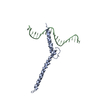
| ||||||||
|---|---|---|---|---|---|---|---|---|---|
| 1 | 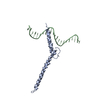
| ||||||||
| Unit cell |
|
- Components
Components
| #1: DNA chain | Mass: 6752.366 Da / Num. of mol.: 1 Source method: isolated from a genetically manipulated source Source: (gene. exp.)   |
|---|---|
| #2: Protein | Mass: 10222.484 Da / Num. of mol.: 1 / Fragment: DNA BINDING DOMAIN Source method: isolated from a genetically manipulated source  Keywords: FRAGMENT: DNA BINDING DOMAIN / References: UniProt: P61244 Keywords: FRAGMENT: DNA BINDING DOMAIN / References: UniProt: P61244 |
-Experimental details
-Experiment
| Experiment | Method:  X-RAY DIFFRACTION X-RAY DIFFRACTION |
|---|
- Sample preparation
Sample preparation
| Crystal | Density Matthews: 3.6 Å3/Da / Density % sol: 61.48 % | ||||||||||||||||||||||||||||||||||||||||||||||||||||||||||||||||||||||||||||||
|---|---|---|---|---|---|---|---|---|---|---|---|---|---|---|---|---|---|---|---|---|---|---|---|---|---|---|---|---|---|---|---|---|---|---|---|---|---|---|---|---|---|---|---|---|---|---|---|---|---|---|---|---|---|---|---|---|---|---|---|---|---|---|---|---|---|---|---|---|---|---|---|---|---|---|---|---|---|---|---|
| Crystal grow | Temperature: 277 K / Method: vapor diffusion, sitting drop / pH: 5.5 Details: pH 5.50, VAPOR DIFFUSION, SITTING DROP, temperature 277.00K | ||||||||||||||||||||||||||||||||||||||||||||||||||||||||||||||||||||||||||||||
| Components of the solutions |
| ||||||||||||||||||||||||||||||||||||||||||||||||||||||||||||||||||||||||||||||
| Crystal grow | *PLUS Temperature: 4 ℃ / PH range low: 5.75 / PH range high: 5.5 | ||||||||||||||||||||||||||||||||||||||||||||||||||||||||||||||||||||||||||||||
| Components of the solutions | *PLUS
|
-Data collection
| Diffraction | Mean temperature: 258 K |
|---|---|
| Diffraction source | Source:  SYNCHROTRON / Site: SYNCHROTRON / Site:  CHESS CHESS  / Beamline: F1 / Beamline: F1 |
| Detector | Detector: IMAGE PLATE |
| Radiation | Monochromatic (M) / Laue (L): M / Scattering type: x-ray |
| Radiation wavelength | Relative weight: 1 |
| Reflection | Resolution: 2.9→20 Å / Num. all: 21448 / Num. obs: 4507 / % possible obs: 85.3 % / Rsym value: 0.065 / Net I/σ(I): 13.9 |
| Reflection shell | Resolution: 2.9→3 Å / % possible all: 61 |
| Reflection | *PLUS Highest resolution: 2.9 Å / Lowest resolution: 20 Å / % possible obs: 85.3 % / Rmerge(I) obs: 0.065 |
| Reflection shell | *PLUS Highest resolution: 2.9 Å / Lowest resolution: 3 Å / % possible obs: 61 % / Rmerge(I) obs: 0.26 / Mean I/σ(I) obs: 2.96 |
- Processing
Processing
| Software |
| ||||||||||||
|---|---|---|---|---|---|---|---|---|---|---|---|---|---|
| Refinement | Resolution: 2.9→6 Å / σ(F): 1 /
| ||||||||||||
| Refinement step | Cycle: LAST / Resolution: 2.9→6 Å
| ||||||||||||
| Software | *PLUS Name:  X-PLOR / Version: 3.1 / Classification: refinement X-PLOR / Version: 3.1 / Classification: refinement | ||||||||||||
| Refinement | *PLUS Highest resolution: 2.9 Å / Lowest resolution: 6 Å / σ(F): 1 | ||||||||||||
| Solvent computation | *PLUS | ||||||||||||
| Displacement parameters | *PLUS | ||||||||||||
| Refine LS restraints | *PLUS
|
 Movie
Movie Controller
Controller


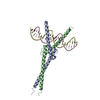
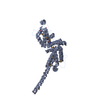
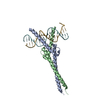


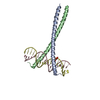
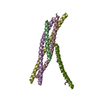

 PDBj
PDBj









































